| |
The road over the Sprengisandur must be commenced
from Húsavík or from Akureyri in the Eyjafjördur. In
the first case a southerly direction is taken to Bárdardalur
in the Sudur-Thingeyjarsysla.
If the traveller starts from Akureyri he follows the road
eastward over the mountains (Vadlaheidi), down to the pic-
turesque Fnjoskardalur, here crossing the Fnjóska at a ford,
near to which is a splendid birch-wood. The parsonage Háls
(neck) is passed, then he enters the Ljósavatnsskard; and
the lake Ljósavatn (the bright lake) soon comes into view.
It contains plenty of trout. Good accommodation at the
farmhouse.
(AkureyriLjósavatn 6 hrs.).
From Ljósavatn a short distance to the Godafoss a
splendid waterfall in the Skjálfandi (the trembling). This stream is
followed in southerly direction through the Bdrdardalar to
the most southern farm Mıri in the valley.
(LjósavatnMıri a long daysride.)
On August 12th 1902, I left Akareyri for Sudur-Thingeyjar-
Sysla. Sigurdur Sumarlidason, an active young man, who
had spent several years in North America, had been
engaged to accompany me on this journey. He had never
crossed the Sprengisandur, but in the Bárdardalur, Jon Oddsson,
an uncommonly plucky and active peasant was to join us. In
1897, Jon Oddsson accompanied me across the sands, and
was later on, commissioned by the Deputy-Governor to
superintend the erection of cairns along the northern part of the
road. This work, begun in 1901, could not be continued
before it had been decided which direction the route should
take through the difficult part of the country along the
glaciers.
After having made a little detour by Mıvatn, I left the
vicarage at Skútustadir on August 19th - and crossed the moor
to the Bárdardalur. It was bitterly cold, and had been
snowing in the mountains, so we did not begin our journey
to the interior with the brightest prospects. After a ride of
6 hrs. we arrived at Bjarnastadir (a farm), having traversed
an undulated tract of land, covered with stunted willow and
birch, and where flocks of ptarmigans frequently rose in
front of our horses. The drifting sand had done great
damage on the border of the valley through which the
Skjálfandi flowed like a silver streak. The farm looked like an
oasis in the sands.
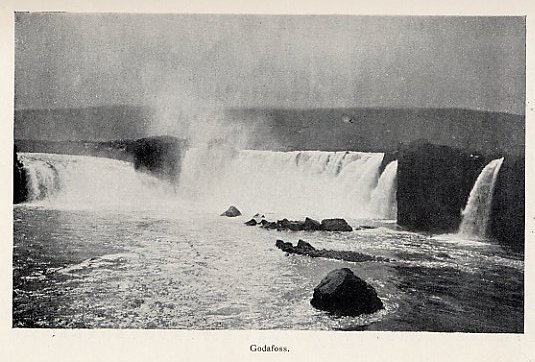
Godafoss
We found Jon Oddsson at Bjarnastadir, where we spent
August 20th preparing for the expedition.
The greatest difficulty we should have to contend with,
would not be the fog, nor the unfordable rivers, nor the
glaciers, but the lack of pasturage for the horses. We had
also to take into consideration, that the unusually cold
weather they had had in Iceland that year, would have
injured the scanty vegetation on the highland. It was therefore
necessary to have as few and as able horses as possible.
Our equipment was exceedingly plain. Each man took one
travelling suit with him, besides an overcoat, and two
changes of undergarments; and we decided to take one tent in
which we could all three sleep. I took a camp-bed which
weighed 7 Ibs., and some blankets. My two companions were
to sleep on the sacks of hay for the horses, and on the skins
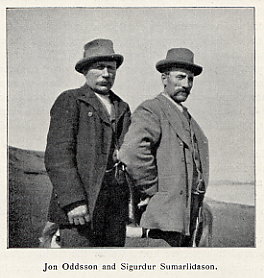
Jon Oddsson and Sigurdur Sumarlidason.
which were thrown across our saddles, their coats and
overcoats to serve as covering for them.
In the usual Icelandic cases, we packed our cooking appa-
ratus, as well as our provisions, consisting of boiled, salted
and smoked mutton, dried fish, bread, butter etc. etc.
(Icelandic products) besides some conserves.
I had three riding horses, which I rode alternately, each
of the men had two, in all twelve, pack-horses included,
quite a little horse caravan. We had to turn out every
morning between 4,30 and 5 o'clock before sunrise. We lighted
a fire to boil the kettle, made our toilet at a neighbouring
stream, had a good breakfast, as we would get nothing to eat
before evening, then packed our things. Finally we got
hold of the horses that were grazing in the pasture, undid
the ropes with which their forelegs were tied together in
order to prevent their straying away, and saddled them.
Although we wasted no time, all this took 2 1/2 3 hrs., so we
could not decamp until about 8 o'clock.
For twelve hours we went on, halting several times, to
give the horses time to rest, and also when I wanted to
reconnoitre.
The day passed quickly, and before we were aware of it,
it was evening; when we came to a pasture, we unpacked and
pitched our tent. The horses rolled in the sand, glad to be
rid of their burden. We tied their forelegs together, and they
hobbled off to graze. We went to a river to refresh
ourselves, then took our supper. After we had lighted the candles,
we smoked a pipe, and went early to rest, but we very
rarely slept soundly; we often awoke, partly on account of
the cold, but especially for fear of the horses attempting to
go homeward, or to better pastures, in spite of their being
tied. We were obliged to get up several times during the
night, to ascertain if they were all there, and soon
discovered that this fear was not groundless. We had to be very
careful, especially where the grass was scarce and poor, but
even where this was not the case, the animals sometimes
felt an irresistible inclination to go back towards the north,
whence they had come. A big grey pack-horse bothered us
more than any of the others; it had several times broken the
rope with which its legs were tied, and then wandered off,
followed by its companions. When this happened, and it was
discovered in time, we hurried after the fugitives, and drove
them back at a rapid pace. After this, they stood sulking for
an hour or so, as if they repented of what they had done,
but no sooner had we fallen asleep, than they started off
again.
We left Bjarnastadir in the morning of August 21st. The
object of our expedition was to explore the Sprengisandur,
in order to find the best routes, partly to the south, to
Árness-Sysla and Rangárvalla-Sysla, along the Thjórsá, partly
to the north, and if possible direct to the interior of the
Eyjafjardardalur.
The reader will perhaps be surprised to learn that these
districts were formerly so slightly known; the reason has
already been alluded to in the introduction. Iceland peasants who
go every year in autumn to the interior of the country to look
for their sheep and lambs, are acquainted with those parts used
as joint pastures, but with no others. To obtain correct
information, one should have to assemble a number of people
from the north and south of the country, and even if this
could be done at great expense and loss of time, there would
still be many remote parts unknown to them.
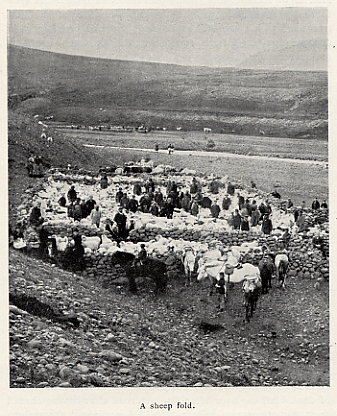
A sheep fold.
Professor Dr. phil. Th. Thoroddsen had several times
visited the country around the Sprengisandur, where he had made
important discoveries east of the Skjálfandi in 1884, south of
the Kaldakvísl in 1889, west of the Thjórsá in 1888 and at the
north end of the Hofsjökull in 1896. Jon Oddsson however,
knew the greater part of the country north, as well as south
of the Sprengisandur, but only on one particular route. We
hoped to be favoured with fine weather, so as to be able to
find our way in those parts, which were unknown to us. It
may be mentioned, that the main route over the Sprengis-
andur had occasionally been used by travellers.
Mıri, and Litla-Tunga in its vicinity, are the only
inhabited farms in the Bárdardalur, but it is not long since that Ishóll,
a farm about 6 miles to the south, was also inhabited. The
forming of settlements here, as well as in other districts in the
interior of Iceland, has greatly decreased. In the middle ages
there were several farms in the interior of Skjálfandafljot,
traces of which are still to be seen. Several proofs of this
depopulation have been found since 1897, when I under-
took to explore this part of the country.
It was now warm, there was not a cloud on the sky, and
in the clear atmosphere, rising above the Ódádahraun, we
saw the snow capped summits of the Askja, the Dyngjufjöll,
and the Herdubreid. We rode from Mıri southward to Ishóll;
on the beautiful lake close by, two loons were swimming.
We stopped near the farm and rested, while little birds flew
twittering about us, and the curlew whistled in the distance.
We visited the ruins of a large farm in the neighbourhood,
and then rode a short way towards the west, ascending the
whole time, then down into the Mjófidalur, so as to get up
to the highlands through this valley. Now and then we came
across young cattle, lambs and sheep, that grazed here in
summer without the care of shepherds or herdsmen.
We proceeded to a good pasture Ytri-Mosar, where we
encamped. While taking our supper here, we heard a
roaring outside the tent, and, peeping out, we saw a herd of
young bulls, which had followed us and were now attacking
our horses and tent; we tried to frighten them, and to chase
them away, but in vain; at last Jon grew impatient, and
mounted one of the horses, took his whip and rode right in the midst
of them. The bulls bellowed, kicked, and gored the ground with
their horns, but after they had felt the whip, they fled,
pursued by Jón. They quickly disappeared in a tremendous cloud
of dust. Half an hour after, Jon returned after having chased
them for about two miles; they did not show themselves
again. We now made our beds, the first time on this
expedition. Jon was in high spirits at the thought of passing some
time in the mountains he was so fond of. When I said:
"Good night", he answered: "Thank you". Afterwards. I heard
him exclaim: ..How delightful it is to be in the mountains".
He was right, such peace and comfort as that of one's tent
of an evening in the highlands when the horses are grazing
outside is only found in nature. The more fatiguing the day
has been, the more one enjoys the moment when the lights
are put out, and one is about to fall asleep. If it is raining
and blowing, the tent seems more cozy than ever, the only
thing which troubles one being the thought of the horses
running off.
It was lovely weather when we started on August 22nd.
We soon passed the next pasture in the Mjofidalur
(Innri-Mosar), and then upward over barren plateaus, towards an
elongated hill, the Kidagils-Hnúkur, for a couple of hours;
the Vatnajökull, and the Tungnafellsjökull covered with ice
and snow, appeared in sight, but rain and fog soon came
on, and when we reached Kidagil I decided to pitch the
tent and recognoitre. Kidagil is a deep ravine, about three
miles long, surrounded by beautiful bassaltic rocks, through
which a river flows, on to the Skjálfandi. The Kidagilsá has
three tributaries, all coming from the sands in the west.
North of the river, on a slope opposite the ravine, there is
a miserable grass-plot called Kidagil; here there is only suf-
ficient fodder for a couple of horses for one night. South of
the ravine and opposite the first pasture, there is a larger
one, Áfangatorfur, but here too the grass is scanty, there
being fodder only for six to eight horses for one night. These
pastures are about twenty minutes walk from the Skjálfandi.
In 1897, we had pitched our tents in the neighbourhood of
Áfangatorfur, at that time there was rather much grass, but
the drifting sand had now completely spoiled this place;
such is always the case in the highland, where grass is a
rare substance. The ruins of three or four houses, south of
the junction of the Kidagilsá and the Skjálfandi prove that
this part of the country was formerly much more fertile.
The sand and earth that covered the ruins have been blown
away; we saw bones, bleached by the sun, among the ruins,
and I even found nails, and other similar things. This must
have been the site of a mountain dairy or a farm.
It rained during the night, and we had to watch the hor-
ses till sunrise. It did not clear up till twelve o'clock next
day, when we again made a start, partly because it would be
impossible to pass another night here owing to the scarcity
of grass. From the place where we pitched our tent, there
is half an hour's ride towards the west, along Kidagil, and
across sandy rocky ground, before one reaches the place
where the Sprengisandur crosses the ravine. The cairns
erected by Jon Oddsson and others begin here, and indicate the
road, a good way southward in the northern part of the
Sprengisandur.
In 1897 I went from Kidagil direct to Eyvindarkofaver, at
the south end of the Hofsjökull in 9 1/2 hrs only. This time
I would not go so far, but break the journey by going to
the Tungnafellsjökull where (as Jon said) there was good
grass to be found in a valley (called Jökuldalur). By making
this halt, the ride across the Sprengisandur becomes very
much shortened, and in future one will be able to ride from
the Mjófidalur direct to this pasture, without stopping at
Kidagil where the pasturage is only poor.
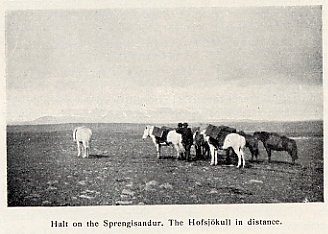
Halt on the Sprengisandur. The Hofsjökull in distance.
After a ride af 2 1/2 hrs from Kidagil we were on a level
with the elongated hill Fjórdungsalda to the west of which
lies the lake Fjórdungsvatn; this year it was very dry, there
was no vegetation around it, and not a bird was to be seen on it.
The Hofsjökull's north east corner is now seen, and we pro-
ceed southward along the Fjórdungsvatn, following a row of
cairns. At the S. end of the lake, we branched off in a S. E.
direction towards the S. end of the Tungnafellsjökull. There
was a dense fog prevailing, but we went on following a horse
track. Jon said this was from the preceding summer, when
the workmen who were building up the cairns, had a few
horses grazing in the Jökuldalur (Jökuldalur = Nıidalur).
We passed Tómasarhagi, a big yellowish mossgrown dip,
where some sheep were grazing, and following the
Fjórdungakvísl we came into the Jökuldalur, after 2 1/2 hrs. quick riding
from the Fjórdungsalda.
Jökuldalur
It was late in the evening when we got there, flocks of
geese flew screeching through the valley, apparently
provoked at our taking possession of their home, but we could
not avoid doing so, as the horses had to be provided with
grass.
We pitched the tent on flat but rather marshy ground, close
to which there was good grass, even Angelica grew in
abundance, on a slope near the tent. The mountains were hidden
by the fog, and a cold wind was blowing. By midnight
everything was in order and we retired to rest.
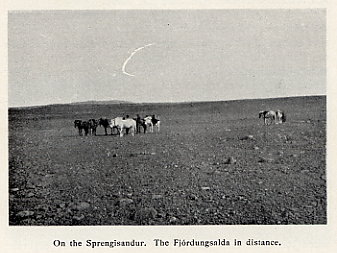
On the Sprengisandur. The Fjordungsalda in distance.
The next day, August 24th, there was a dense fog and
drizzling rain, and as we wanted to get a view from the
mountains, we had to wait for favourable weather; meanwhile we
strolled about the deep valley. A lamb was seen here and
there in the clefts of the rocks, appearing like a white spot;
on one occasion the spot seemed stationary, and on
investigation, we discovered that it was a dead sheep from the
previous winter. Later on we found other dead sheep, the
marks on their ears showing that they were from the
Bárdardalur. These poor sheep had evidently escaped the notice
of the men who in 1901 went to the mountains to drive
them down, and following the river, they had gone up the
valley. As a rule, sheep cannot live a winter through in the
interior of Iceland. There is only one instance on record.
It is incredible how far the sheep can roam. Jon told us
that some people from the Bárdardalur had once driven
their sheep (some ewes) to the south part of the country, in
order to have the race mixed. This was in July; on the way
back, some of the sheep ran away from their owners near the
Budarhals, and in January one of them came down in good
condition to Mıri, after having crossed the Sprengisandur
in mid-winter.
In the evening when the fog lifted, I rode up the moun-
tains, and obtained a beautiful view of the sands and the gla-
ciers. On the rocky sterile mountains we saw some snow-
sparrows and a ptarmigan here and there.
On the night of August 24th we had beautiful moonlight;
the wind was from the south, but it was very cold. After
sunrise on the 25th the clouds came up the valley and a dense
fog followed, but Jon assured us (and he was right) that it
would lift about 11 o'clock, so we started early and went
across the sands to the district near the Hofsjökull, at the
base of which we marked off the road towards the S.,
following the course of the Thjorsd to Eyvindarkofaver. There
we pitched our tent, near the ruins (which I had examined
some years ago) of the miserable hut of an outlaw, Eyvind,
who lived there about a hundred years ago.
After having carefully tied the horses legs, we let them
loose in the boggy pastures, and went to bed, thinking there
would be no danger here, as there was good grass. The last
time I heard the horses grazing outside, was between 3 and
4 o'clock, just before dawn, so I was very much surprised
when Jon came into the tent at 4,30 and awoke Sigurdur
and myself saying: "The horses are gone".
We jumped up and rushed out. It was somewhat misty,
but we could see a good distance, although the sun had not
yet risen. We looked, and looked, but the horses must have
hidden themselves in a dip. We all went in a different
direction to search for them, and soon afterwards I heard a
cry in the distance: "They have gone towards the north,
here is their track". Suddenly I saw Jon and Sigurdur
running across the hills following their track. Meanwhile I went
up a hill to reconnoitre, but saw nothing. In about three
hours, however the men returned with the horses at full
speed having found the fugitives about 4 miles to the north.
They were led by the grey pack-horse, and were making for
home. The animals looked very sleepy and stupid, while
we packed our things, and placed the burdens on their backs.
The fog lifted, the sun broke forth and a beautiful
rainbow appeared in the sky just as we started southward along
the Thjorsd, in the direction of Hvannagil, a pasture north
of the Búdarhals.
We expected to have an easy ride, but were soon
disappointed at having to encounter difficulties of the worst kind.
First we had to contend with the soft sandy bed of a stream,
and on crossing the Thúfuverskvísl later on, we had a narrow
escape. The banks looked quite safe, and we never dreamed
of danger. Jon went on to find a place where he could ford
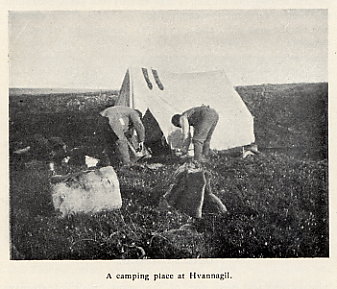
A camping place at Hvannagil.
the river, and he began to cross it. The bed of the river
was a little soft, but not so bad that we could not follow;
he was just on the point of reaching the opposite bank, when
both horse and rider almost disappeared. They tumbled about
in the water for a few minutes, when Jon got up, but he
could not pull the horse up; with distended nostrils it
rolled about struggling in the quick-sand, and it was only after
considerable exertion that Jon succeeded in getting it ashore.
For some time I looked about for a better place to cross
the river, and finally found one, close to where it comes
down over a basaltic rock, like a small waterfall.
Shortly afterwards we halted near Thufuver, a fertile pasture,
where the people from the south encamp when they go to the
mountains for their sheep, and where they have constructed
a small sheepfold. We again continued our journey, passing
by the Soleyjarhofdi and heading towards the south along the
Thjórsá. We had again to cross some streams with quick-
sand, so the horses were very tired, when we reached
the pasture Hvannagil in the evening; here can be seen a
beautiful waterfall in the Thjórsá.
The weather had been magnifieient the whole day, and we
had had a beautiful view of the glaciers. It was oppressively
hot when the sun shone, and bitterly cold when it
disappeared behind the clouds. I had exactly the same sensation
as when I sat near the camp fires in Africa. One was too
hot on the one side, and as cold as ice on the other.
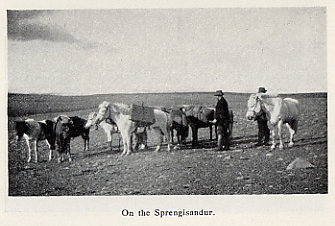
On the Sprengisandur.
We pitched our tent near one of the many pools of stagnant
water between mounds of sand covered with Salix Glauca.
We felt cold in the tent, and could not sleep for fear of the
horses escaping; at last I fell asleep, but was soon awakened,
with the news that the horses had disappeared; it was then half
past two, and pitch dark, but nevertheless they were found
and brought back. The night passed without further disturb-
ance, and after a good cup of coffee, we were alright again.
At sunrise we washed and dressed, near one of the pools;
there was a coating of ice on it, and at the bottom, the
impression of swan's feet was distinctly visible, and feathers were
scattered about. We took advantage of the beautiful weather to
arrange several things, such as shoeing the horses, repairing
broken boxes etc. etc. We started on a little trip southward at
10-30, and thereby ascertained that the route could be continued
to the Tungnad and that the Klifshagavellir lies much too far
towards the east on the maps (a ride of 34 hours). During
the whole ride we enjoyed the beautiful view of the Hekla,
and the mountains in its vicinity. In the evening we returned
to Hvannagil, as I dared not attempt to go further south on
account of the cold, and the prospect of a snowstorm; the
mountains were entirely covered with snow. We had
therefore to be content with our reconnoitring along the
Kaldakvísl, in which there was much more water than usual.
We went so far east that we could see Illugaver, and the
country south of Vonarskard, behind which the Vatnajökull's
white surface is seen.
Again that night the horses attempted to get away but
were captured.
This would have been almost the worst place it could
have happened; we were certainly not far from inhabited
districts in the south part of the country (a ride of one day
and a half) but we could not have crossed the Tungnaá,
because the boats that the peasants use when they take their
sheep to the mountains, were all on the north-side of the
river.
It would have taken us three days to ride to the inhabited
districts in the north. To cover this distance on foot would
have taken us double the time, as we should have had to
take provisions and a tent with us so it was most
fortunate that we recovered our horses.
On August 28'h we began our journey northward, taking
this time a route more to the east, and about one mile from
the Thjórsá, thus avoiding the soft sandy tracts near the
outlets of the streams. At the same time we marked off a
good road. We reached the Sóleyjarhöfdi, the ford across the
Thjórsá generally used, and crossed without any obstacles,
then we let the horses graze west of the river near a hut.
We again proceeded northward so as to get to Náthagi (a
place close to the Hofsjökull) before sunset. Jon said that
there were hot springs there, and luxuriant vegetation.
South of the Hofsjökull the beautifull light summits of
the Kerlingarfjöll were seen in the distance, between which,
gleamed the eternal snow. In the narrow valleys of the
Kerlingarfjoll there are hundreds of hot springs, which I visited
in 1897.
Following the Blautakvísl, we made a curve in a westerly
direction, so as to avoid the various rivulets which come from
the Hofsjökull; these unite, and form large rivers which empty
themselves into the Thjórsá. Later on we crossed the
Blautakvísl at its broadest part, and made for a group of
mountains on the border of the Hofsjökull.
About 6 o'clock in the evening we went round a little
promontory, and were very much surprised to see a green
plain abundant in vegetation, below the cold white glaciers.
The vapour from a hot spring was seen rising up from the
plain, and along the stream, flowing from the spring,
vegetation was most luxuriant. Among other plants there were
gigantic Angelica. The temperature of the spring was, at a
rough estimate over 35 ° Celsius. But at a distance of less
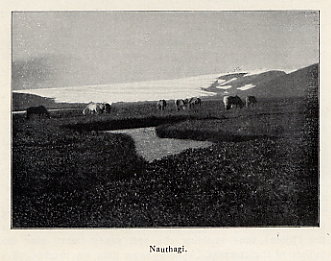
Nauthagi.
than 100 feet from the place where the hot water ran into a
tributary of the Miklakvísl (from the jökull) the water is
very cold, there being ice near the banks. We saw
stickleback swimming from the cold into the warm water.
The name Nauthagi is derived from Naut (young cattle).
About 50 years ago, two heads of cattle ran away from
Reykjavík and were found here.
Webfooted birds lived in this oasis. We saw a flock of
timid swans at a distance in the meadow, while flocks of
noisy geese flew backwards and forwards in the
neighbourhood of our tent, curious to know what we were doing there.
After the sun had disappeared behind Arnarfell hid mika
(at Hofsjökull), I heard the quacking of ducks in the stillness
of the night, and when crossing the swamp to see to the
horses before going to rest, I roused a ptarmigan which gave
them a fright.
After nightfall, the glacier loomed dark and threatening near
us, but above it the atmosphere was clear and sparkling,
and in the east, on the other side of the Thjórsá, we saw
the Vatnajökull, with its two big characteristic promontories
Hágöngur. At sunset, the Hekla was just visible when the
sun shone on its snow-capped summit.
I hurried off to bed, after a bath at the hot springs. It
was bitterly cold during the night, and when we came out of
the tent at sunrise a keen wind was blowing from the glacier.
As the sun rose it grew warmer, and we took our time, for
we had much to repair before making a start, and besides
there was no hurry, as we did not intend to go further than
Arnarfell hid mikla, a mountain 2 1/2 to 3 hours from here.
We rode along the base of the glacier, crossed the
Miklakvísl, and later on all the Múlakvíslir which come from a
projecting corner of the glacier towards the south east. They
pass through the mounds of gravel and sand which girth
the glacier.
Here and there on the outer slope of these mounds, we
"saw some very old bridle-paths winding through beautiful
grassy patches. Now and then curlews flew up from the
ground, ptarmigans ran through the heather and willow with
their full-grown young, or they rose, and flew a short
distance from us. Sometimes we came across some deserted
breeding places of swans, covered with feathers. We enjoyed
looking at the snow-birds, or we chased the titlarks along
the paths while they tried to hide themselves.
Across the milky water of the Múlakvíslir we saw the
mossgrown plains near the Thjórsá, and if we looked in the
opposite direction towards the glacier, we could see the big dark
mounds of gravel piled up in front of the cold, almost even
surface of the glacier; all the Múlakvíslir force their way
through this mound. One of these rivulets had recently
broken through a new place, and carried a quantity of gravel
and mud down over the plain. This very often happens. The
rivers frequently change their beds, and the maps can
only state their names. All the Múlakvíslir form, west of the
little hill Arnarfellsalda, one river which empties itself into
the Thjórsá. After the Múlakvíslir, we crossed the
Arnarfellskvíslir near Arnarfell id mikla.
At the foot of this beautiful mountain, we encamped on a
slope facing the south, abounding in grass, flowering plants,
angelica the height of a man and various other plants.
This grass plot formed a strange contrast to the glacier,
and the barren gravel and stony tracts in the neighourhood.
Tempted by these comparatively fertile spots the
previously mentioned outlaw Eyvind made his abode there. He had
lived a long time at Eyvindarkofaver, but did not feel safe
there, so he settled down with his wife at Arnarfell. The
place where he lived is no longer known, being hidden in
the gravel from the glacier. He spent one summer here, and
seized the opportunity of stealing a number of lambs and
sheep from the "Afrjettir" (joint pastures), 80 of these he
slaughtered for food in the winter, but the peasants discovered
his hut and took possession of the stolen goods. Eyvind was
obliged to give up living in the mountains, and had to
resort to inhabited places.
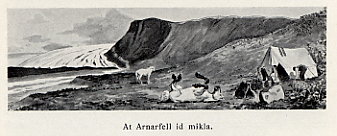
At Arnarfell id mikla.
The pasture near Arnarfell id mikla and probably that near
Nauthagi have evidently been more frequented formerly than
now.
At that time the road west of the Thjórsá was sometimes
used. J. C. Schiödte for instance, slept one night at
Nauthagi on his journey in 1840 to Vonarskard and further on
via Vatnajökulsvegur. The road at that period was evidently
at times worse than it is now, and one was even obliged to
go up on the glacier. Only sixteen years ago a peasant had
to do so, as he could not get on along the base owing to the
softness of the soil. It was old Gudmandar, a well known
guide of the Sprengisandur, but he was most unfortunate.
He had five horses with him, and had taken the wrong road
owing to the fog; one of the horses fell into a fissure of the
glacier, which the snow had completely covered, he tried to
pull it up with a rope, but as he did not succed, he was
obliged to kill it.
On August 30th we got up at 4,30, the sun rose about
6, and we were soon ready to start. We left this lovely place
to proceed to the main route of the Sprengisandur, across
the Thjórsárkvíslir. The first two hours we had to ride step
by step across the stony plains, in front of the moraines;
later on we rode towards the N. E. and crossed the largest
of the Thjórsárkvíslar. Safe and sound we reached the main
road, where a few days ago we had marked off the place
where the road should diverge towards Arnarfell.
The road along the glacier had proved to be rather good,
and there is no doubt that it will be advantageous, espe-
cially when one cannot reckon on crossing at the Soleyjar-
hofdi on account of the swollen rivers.
In the mounds of gravel, N. of Arnarfell id mikla. I found
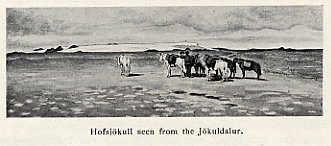
Hofsjökull seen from the Jökuldalur.
big pieces of obsidian evidently brought down by the ice
from the remote parts of the Hofsjökull. They were strewn
over large tracts. In a few places there was abundant
vegetation. Snow-birds, and other small birds, as well as curlews
were often seen. We went to the Jökuldalur and encamped
for the night.
It had proved that the route leading across the
Sprengisandur could easily be continued as well to
Rangárvalla-Sysla (E. of the Thjórsá) as to Arness-Sysla (W. of same
river) after the Sóleyjarhöfdi is passed. The road along the
Hofsjökull or the Arnarfell road had also proved to be good.
Now we had only to find a more direct route to the interior
of the Eyjafjardardalur. This was our task the last days we
were in the highlands.
From the Jökuldalur we went S. of the Fjordungsalda, and
towards the N. W. to the Laugafell, an isolated mountain N
of the Hofsjökull. In fine weather it can be seen from all parts.
None of us had ever visited these regions, which on the
whole were very little known.
When we were to leave the Jökuldalur, it was most unfor-
tunate, as this was the very day we were to find our way
through districts unknown to us.
After a few hours ride the fog lifted and we went on
towards the Laugafell, constantly ascending and crossing the
tract of land with the watershed between the tributaries of the
Thjórsá, the Skjálfandi, and the Jökulsá Eystri (to the
Skagafjördur). After having crossed the main road, which is indicated
by cairns, we crossed the Bergvatnskvísl or Bergkvísl, that
joins the Thjórsá. We reached the mountains S. E. of the
Laugafell, on the above mentioned watershed, after having
traversed plains of gravel and sand. From here we had a
beautiful view of the vast desert. The country S. of the
Laugafell, and down to the Hofsjökull, is one of the most
barren tracts in Iceland. We saw distinctly the most N.
tributary of the Thjórsá flowing from the N. E. corner of the
glacier, where a little conical shaped mountain Litla Arnarfell
is to be seen, we saw the two arms of the river
Bergvatnskvísl, one of them being only ten minutes ride from the
Laugakvísl. We followed the Laugakvísl, ascended the
Laugalda on horseback and enjoyed the beautiful and extensive view
once more. In the W., we saw the Mælifellshnjúkur, in the S.,
the HofsJökul, in the S. W. and W the Vatnajökull with the
Hágöngur, the Tungnafellsjökull, in the E. the Ódádahraun
with the Dyngjufjöll, the Kistufell, and the Trölladyngja;
the horison is obscured by the heights near Kidagil in the N.
E., and the Vatnahjalli in the N.
We then descended the mountain to look for the hot
springs, which, according to Thoroddsen, are in the vicinity
of one of the tributaries of the Laugakvísl. After searching
a short time we found the three hot springs, (Laugar 38°
40 ° C. of heat) emerging from a stream of cold water; along
this brook there was a little vegetation, but we were rather
disappointed at not finding sufficient grass for our horses for
one night, so I determined to go on immediately.
Tradition says that as long as the plague lasted, there were
mountain dairies near the Laugafell. There are said to be
ruins from that time, which I looked for on my way, but
failed to discover them. For the sake of the horses we were
obliged to push on, so as to reach Eystri Pollar (two grassy
swamps with small lakes and ponds) before nightfall. First
we crossed a small river, and after a ride of P/a hrs. from
the hot springs, we reached the most southern swamp, where
we encamped in a dip, with little knolls covered by grass
and Salix Glauca.
We were now on the so called Vatnahjallavegur (which
connects the interior of the Eyjafjardardalur with the
Kjalvegur) a pass very much used in olden days, although it was
very long and stony. In 1897 I had surveyed a part of it
towards the west as far as the Jökulsá-eystri. I had not
travelled along the other part of the road myself, but had seen
most of it at a distance. The late Mr. F. R. Howell, an English-
man, had given me some information about the route. Thor-
oddsen has described a part of it.
From Eystri Pollar the road leads in a N. direction over
rather stony ground to Geldingsa (a pasture) from there it
runs more to the N. (towards the Vatnahjalli) across very
rocky ground, where the horses could hardly find foothold.
On September 1st after a very cold night, we began the
last stage of our journey, and after having crossed very
rocky tracts of land, we reached the Ullarvotn, some small
lakes with barren surroundings. Here we rested, lunched,
and prepared for the fatiguing ascent towards the mountain
Vatnahjalli, whence we should descend into the valley. We
had been informed that it would take us 45 hrs. to ride
from the lakes down into the Eyjafjardardalur.
As it was fine weather I gave the horses the hay we had
with us. My companions had wished to get rid of it several
times, but I thought we ought to keep it, as there was no
knowing what might happen. After luncheon, while the
horses were being saddled, I went on in advance, as I often did.
While ascending the very rocky side of the mountain, I saw
clouds of fog drifting up to the plateau, evidently from the
Eyjafjardardalur. I now waited for the horses. The fog grew
more and more dense, and before we had reached the
border of the valley, we were in total darkness. We had to
dismount and grope our way; sometimes the cairns helped us
to find the right direction, but misled us when they were
not in the right places. We kept all the horses together, and
as soon as we had found a cairn, I sent a man on to look
for the next one and when we heard his call we followed him.
In this way we proceeded for some time, but at last we could
find no more cairns, and had to go on at hap-hazard. We
felt however, that we were descending, and we heard the
sound of water rushing through a ravine. We followed the
brink of the ravine, and after groping about for a few hours,
we reached the slope of a mountain, where the fog began
to lift. We saw at our feet a lovely green valley, in which
the sun was shining, and where horses were grazing. At a
little distance, we saw a cluster of houses, which proved to be
the farm that lies furthest up the Eyjafjardardalur. After a
halt on the slope, where the horses got a good feed, we
went down into the valley by a very difficult path. Here we
saw the haymakers in the meadows, and to us, coming from
the uninhabited parts of the country, it was a most beautiful
sight. Sigurdur rode up to them, and asked where we could
pass the night.
They stared at him.
"Where do you come from?"
"From the Sprengisandur."
"The Sprengisandur?"
"Yes certainly."
"But how did you find your way across the mountains in
that fog?" they asked looking amazed.
Soon after we were safe and sound at the farm Tjarnir.
|
|












![]() Zurück zu Inhalt
Zurück zu Inhalt![]() nächstes Kapitel
nächstes Kapitel